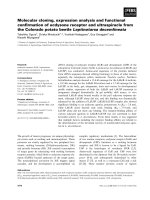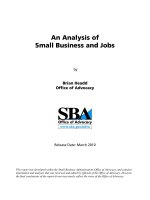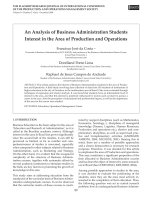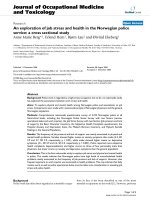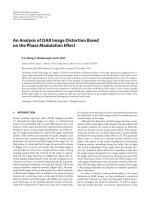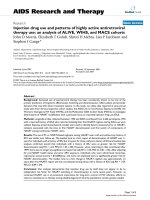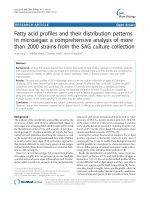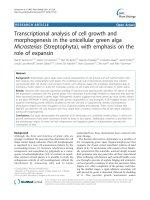AN ANALYSIS OF a SUGGESTED TRANSLATION OF CHAPTER 3 AND 4 FROM THE BOOK “NO NAME” BY WILKIE COLLINS, 2006
Bạn đang xem bản rút gọn của tài liệu. Xem và tải ngay bản đầy đủ của tài liệu tại đây (368.58 KB, 80 trang )
MINISTRY OF EDUCATION AND TRAINING
DUY TAN UNIVERSITY
FACULTY OF ENGLISH
DUY TAN UNIVERSITY
GRADUATION PAPER
PHAM THI LAN ANH
AN ANALYSIS OF A SUGGESTED TRANSLATION OF
CHAPTER 3 AND 4 FROM THE BOOK “NO NAME” BY
WILKIE COLLINS, 2006.
GRADUATION PAPER IN SOCIAL SCIENCES AND HUMANITIES
DA NANG – MAY 2021
MINISTRY OF EDUCATION AND TRAINING
DUY TAN UNIVERSITY
FACULTY OF ENGLISH
DUY TAN UNIVERSITY
GRADUATION PAPER
PHAM THI LAN ANH
AN ANALYSIS OF A SUGGESTED TRANSLATION OF
CHAPTER 3 AND 4 FROM THE BOOK “NO NAME” BY
WILKIE COLLINS, 2006.
MAJOR : ENGLISH FOR TRANSLATION AND INTERPRETATION
CODE : K23.701
SUPERVISOR: LE THI DIEU HUONG, M.A.
DA NANG – MAY 2021
GRADUATION PAPER
1
Supervisor: Le Thi Dieu Huong, M.A.
ACKNOWLEDGEMENTS
This graduation paper could not be finished without the invaluable help,
guidance, and encouragement of many people.
First of all, I would like to express my deepest gratitude to Mrs. Le Thi
Dieu Huong, my supervisor at Duy Tan University - who gave me useful
comments, invaluable advice and good suggestions for my graduation essay.
Thanks to her care and kindness, I could find out my drawbacks and
improved them in order to complete this graduation paper as best as I can.
Secondly, I would like to extend the sincerest thanks to all teachers from
Faculty of English at Duy Tan University for teaching and leading me during
4 year. Had it not been for their diligent instruction, I and other students
would not have achieved the good results and sustainable knowledge
background. In addition, they were the ones who always guided us through
difficulties and challenges.
Thirdly, I would like to say thanks to my friends for their contribution to
my translation process. I never forget what my friends helped me in this
period.
Lastly, I especislly acknowledge my family’s support. My family is
always beside me and supports me during a long time of studying at Duy Tan
University.
I wish all of you a good health, happiness and success!
Your Sincerely!
Pham Thi Lan Anh
Student: Pham Thi Lan Anh
Code: K23.701
GRADUATION PAPER
2
Supervisor: Le Thi Dieu Huong, M.A.
STATEMENT OF AUTHORSHIP
Except where reference is made in the text of the thesis, this thesis
contains no material published elsewhere or extracted in the whole or in part
from a thesis by which have qualified for or been awarded another degree or
diploma.
No other person’s work has been used without due acknowledgement in
the thesis.
This thesis has not been submitted for award of any degree or diploma in
any other tertiary institution.
Danang, May 2021
PHAM THI LAN ANH
Student: Pham Thi Lan Anh
Code: K23.701
GRADUATION PAPER
3
Supervisor: Le Thi Dieu Huong, M.A.
ABSTRACT
The book “No Name” by Wilkie Collins is about sensation novels. I
choose to translate chapter 3 and 4 so that it will be easier for the readers to
get the main ideas of this book. Besides, I also analyze some necessary issues
such as multi-meaning vocabulary and complex grammar structures in this
chapter. In addition, through this graduation paper, I also find out some
difficulties in educational translation and put forward some effective
solutions.
Student: Pham Thi Lan Anh
Code: K23.701
GRADUATION PAPER
4
Supervisor: Le Thi Dieu Huong, M.A.
ABBREVIATIONS
SL : Source Language
TL : Target Language
Student: Pham Thi Lan Anh
Code: K23.701
GRADUATION PAPER
5
Supervisor: Le Thi Dieu Huong, M.A.
TABLE OF CONTENTS
ACKNOWLEDGEMENTS.............................................................................i
STATEMENT OF AUTHORSHIP................................................................ii
ABSTRACT....................................................................................................iii
ABBREVIATIONS.........................................................................................iv
CHAPTER 1. INTRODUCTION..................................................................1
1.1. Rationale...................................................................................................1
1.2. Aims and Objectives.................................................................................2
1.2.1. Aims.....................................................................................................2
1.2.2. Objectives............................................................................................2
1.3. Scope of the Study....................................................................................2
1.3.1. Text Features........................................................................................3
1.3.2. Text Length..........................................................................................3
1.3.3. Text Organization................................................................................3
1.3.4. Text Source..........................................................................................3
1.4.Methods of the study..................................................................................3
1.4.1. Translating Method..............................................................................3
1.4.2. Analyzing Method...............................................................................4
CHAPTER 2. THEORETICAL BACKGROUND.......................................5
2.1. Translation Theory....................................................................................5
2.1.1. Definitions of Translation....................................................................5
2.1.1. Types of Categories...........................................................................6
2.1.1.1. Full versus Partial Translation..........................................................6
2.1.1.2. Total versus Restricted Translation...................................................6
2.1.1.3. Phonological Translation..................................................................7
2.1.1.4. Graphological Translation................................................................7
Student: Pham Thi Lan Anh
Code: K23.701
GRADUATION PAPER
6
Supervisor: Le Thi Dieu Huong, M.A.
2.1.1.5. Transliteration...................................................................................7
2.2. Methods and Principles..............................................................................8
2.2.1. Methods of Translation............................................................................8
2.2.1.1. Word-for-word Translation...................................................................8
2.2.1.2. Literal Translation................................................................................8
2.2.1.3. Faithful Translation..............................................................................8
2.2.1.4. Semantic Translation............................................................................9
2.2.1.5. Adaptation Translation.........................................................................9
2.2.1.6. Free Translation....................................................................................9
2.2.1.7. Idiomatic Translation..........................................................................10
2.2.1.8. Communicative Translation...............................................................10
2.2.2. Principles of Translation........................................................................10
2.2.2.1. Meaning..............................................................................................10
2.2.2.2. Form...................................................................................................11
2.2.2.3. Register...............................................................................................11
2.2.2.4. Source Language Influence................................................................11
2.2.2.5. Idiom..................................................................................................12
2.2.2.6. Style and Clarity.................................................................................12
CHAPTER 3: SUGGESTED TRANSLATION..........................................13
CHAPTER 4: ANALYSIS............................................................................44
4.1. Difficult words and Phrases....................................................................44
4.1.1. Words with Multi-meanings..............................................................44
4.1.2. Phrasal Verbs.....................................................................................48
4.1.3. Idioms and Expressions.....................................................................51
4.2. Challenging Structures............................................................................54
4.2.1. Sentences in Passive Voice................................................................54
4.2.2. Compound Sentences........................................................................55
4.2.3. Complex Sentences...........................................................................57
4.2.3.1. Complex Sentences with Noun Clause.........................................57
Student: Pham Thi Lan Anh
Code: K23.701
GRADUATION PAPER
7
Supervisor: Le Thi Dieu Huong, M.A.
4.2.3.2. Complex Sentences with Adjective Clause (or Relative Clause)..59
4.2.3.3. Complex Sentences with Adverbial Clause..................................60
4.2.4. Sentences with Empty Subjects.........................................................63
CHAPTER 5: DIFFICULTIES AND SOLUTIONS..................................65
5.1. Difficulties..............................................................................................65
5.2. Solutions..................................................................................................66
CHAPTER 6: CONCLUSION AND SUGGESTIONS..............................68
6.1. Summary of Findings..............................................................................68
6.2. Suggestions.............................................................................................69
REFERENCES..............................................................................................70
SUPERVISOR’S COMMENTS...................................................................71
Student: Pham Thi Lan Anh
Code: K23.701
GRADUATION PAPER
1
Supervisor: Le Thi Dieu Huong, M.A.
CHAPTER 1. INTRODUCTION
1.1 . Rationale
As one of the students of Faculty of English at Duy Tan University, I
have given opportunities to approach and understand many types of
interpreters related to several disciplines. However, translating a book related
to a novel was the most interesting to me.
Besides, the number of people pursuing the translation industry is quite
large nowadays. Translation is a difficult industry that requires good foreign
language skills and a lot of vocabulary. Getting a complete Vietnamese
translation is not easy.
In fact, book readers increase each day that the quality of the novel is
increasingly confirmed. Every year, novels are published around the world. A
novel was chosen for translation because the translator was interested in the
text as well as wanted to know the language style in the English novel.
Moreover, knowing how to overcome the idiom or slang words transition
from English to Vietnamese without changing the message of the text is also
considered to be the reason in choosing it. I think it was extremely helpful to
choose this book for translation in order for me to better understand all
aspects of my social life.
Hopefully when translating this book, readers may be impressed that this
novel is illegal, combined social commentary - the absurdity of the law as
applied to children of unmarried parents - with a densely plotted revenge
thriller.
In short, I hope that AN ANALYSIS OF THE SUGGESTED
TRANSLATION OF CHAPTER 3 AND 4 FROM THE BOOK “NO
Student: Pham Thi Lan Anh
Code: K23.701
GRADUATION PAPER
2
Supervisor: Le Thi Dieu Huong, M.A.
NAME” BY WILKIE COLLINS will bring a different perspective on social
commentary in the Victorian literary market.
1.2. Aims and Objectives
1.2.1. Aims
Identifying some new ways to help people and myself to search for our
full potential so that we could get better and reach for greater deals in life.
Giving the comfort what is in this book for the readers/novel lovers.
Improving translating skills through difficult vocabulary and grammar
structures as well as unfamiliar idioms and expressions.
Increasing knowledge about method, process and identifying the steps
of translation.
1.2.2. Objectives
After completing the graduation paper, I had gained several noticeable
purposes as follows:
Summing up the knowledge that I have learned for nearly 4 years at
university.
Grasping the use of difficult vocabulary and idioms which are usually
used in education aspect.
Translating text more clearly, easy to understand and as natural as
possible.
Getting to know how to deal with complicated sentence structures.
Student: Pham Thi Lan Anh
Code: K23.701
GRADUATION PAPER
3
Supervisor: Le Thi Dieu Huong, M.A.
Mastering translating skills and the ways to express equivalent ideas in
both English and Vietnamese.
Gaining more knowledge about educational reality and changes.
1.3. Scope of the Study
In this graduation paper, I would like to offer a suggested version in
Vietnamese language for the English version of chapter 3 and 4 from the book
“No Name” by Wilkie Collins. In addition, I also analyzed some difficult
vocabulary and grammar structures that I encountered during the process of
translating this text.
1.3.1. Text Features
This book was published in 1862 by S. Low, Son & Co. in London.
Written in English. No Name is a 19th-century novel by the master of
sensation fiction, Wilkie Collins. A country gentleman is killed in an accident
and his wife dies shortly after him. The blow is double for their daughters,
who discover that they were born before their parents were married. Their
sudden illegitimacy robs them of their inheritance and their accustomed place
in society.
1.3.2. Text Length
The book “No Name” overall has 8 scenarios. The text I choose to
translate belongs to chapter 3 and 4 of the first scene - with about 4500 words.
1.3.3. Text Organization
“No Name” has 15 chapters and I choose the chapter 3 and 4 of the first
scene to translate. The text is divided into main parts and it is organized as
follows:
Chapter 3
Student: Pham Thi Lan Anh
Code: K23.701
GRADUATION PAPER
4
Supervisor: Le Thi Dieu Huong, M.A.
Chapter 4
1.3.4. Text Source
The text is chapter 3 and 4 from the book “No Name” written by Wilkie
Collins. “No Name” was published on 18th March, 2006.
1.4.Methods of the study
I implemented this study based on two main methods:
1.4.1. Translating Method
Translating the text and paying attention to highlighted terms, idioms,
and structures of the text.
Highlighting ambiguous vocabulary and difficult grammar structures.
Scanning and skimming the whole text to get the main content of the
text.
Discussing with the supervisor and friends as well as searching on the
Internet to get the most suitable meanings for those words and structures.
Checking for mistakes in suggested translation.
1.4.2. Analyzing Method
Analyzing difficult vocabulary and grammar structures based on
translation and grammar theories after completing translation process.
Finalizing the study.
Student: Pham Thi Lan Anh
Code: K23.701
GRADUATION PAPER
Student: Pham Thi Lan Anh
5
Supervisor: Le Thi Dieu Huong, M.A.
Code: K23.701
GRADUATION PAPER
6
Supervisor: Le Thi Dieu Huong, M.A.
CHAPTER 2. THEORETICAL BACKGROUND
2.1. Translation Theory
2.1.1. Definitions of Translation
The theory of translation is involved in a certain type of relation
between languages and is consequently a branch of Comparative Linguistics.
Translation may be set up and is performed between any pair of languages or
dialects and with any kind of spatial, temporal, social or other relationships
between them.
There are many ways to definite a notion. We will have a different
definition because it depends on the personal view of each person. Therefore,
the definition of translation is not unique. Evidently, there are many languages
in the world, so they are well-defined translation in many different ways.
These are some definitions of translation as follows:
“Translation is the replacement of textual material in one language (SL)
by equivalent textual material in another language (TL)” - J.C. Catford,
1965.
“Translation is the process of conveying messages across linguistic and
cultural barriers” - Ian Tudor, 1987.
“Translation is the expression in another language (target language) of
what has been expressed in one language (source language), preserving
semantic and stylistic equivalencies” - Thakeray.W.M., 1796.
“Translation is a process of rendering the meaning of a text into another
language in the way that the author intended the text” – Peter Newmark.
These concepts support the idea that translation is a complex process
which requires also theoretical knowledge as well as practical experiences.
Student: Pham Thi Lan Anh
Code: K23.701
GRADUATION PAPER
7
Supervisor: Le Thi Dieu Huong, M.A.
2.1.1. Types of Categories
There are types of categories of translation which may be defined in
terms of extent, levels and ranks of translation. We can deeply understand and
easily distinguish the ways of translation to help us avoid making mistakes
when translating.
2.1.1.1. Full versus Partial Translation
When doing translating, almost all translators have to face up two big
problems as follows: trying to convert everything, or leaving some
untranslated. According to J.C. Carford, translation falls into two categories:
full and partial.
(i)Full Translation: the entire text is submitted to the translation process:
that is, the TL material replaces every part of the SL.
Example:
We should study hard to pass our final exams.
Chúng ta nên học tập chăm chỉ để vượt qua kỳ thi cuối cùng của
chúng ta.
(ii) Partial Translation: some part or parts of the SL are left untranslated:
they are simply transferred to and incorporated into the TL.
Example:
Cu đơ là món đặc sản của Hà Tĩnh.
“Cu do” is special food in Ha Tinh.
2.1.1.2. Total versus Restricted Translation
This distinction relates to the levels of language involved in
translation. In “total” translation, all levels of SL text are replaced with TL
material.
(i) Total Translation is usually meant by ‘‘translation’’ most of the time:
that is, translation in which all levels of the SL text are replaced by TL
material.
Student: Pham Thi Lan Anh
Code: K23.701
GRADUATION PAPER
8
Supervisor: Le Thi Dieu Huong, M.A.
Example:
Nothing is forever. Khơng có gì là mãi mãi.
Have you ever been to Ha Tinh? Bạn đã bao giờ đến Hà Tĩnh chưa?
(ii) Restricted Translation is the replacement of SL textual material by
equivalent TL textual material, at only one level, that is translation
performed only at the phonological or at the graphological level, or at only
one of the two levels of grammar and lexis.
Example:
In America, they eat what they can, and they can what they can’t.
Ở Mỹ, họ ăn những gì ăn được và đóng hợp những gì họ khơng ăn
được.
2.1.1.3. Phonological Translation
Phonological translation is restricted translation in which the SL
phonology of a text is replaced by equivalent TL phonology. The grammar
and lexis of the SL text remain unchanged, except insofar as random
grammatical or lexical deviations are entailed in the process.
Example:
Piano Pi – a – nô
Gilet Ghi – lê
2.1.1.4. Graphological Translation
SL graphology is replaced with equivalent target one without other
considerable replacement.
Example:
Carrot Cà – rốt
2.1.1.5. Transliteration
In transliteration, SL graphological units are replaced with
corresponding SL phonological units. Then these SL phonological units are
Student: Pham Thi Lan Anh
Code: K23.701
GRADUATION PAPER
9
Supervisor: Le Thi Dieu Huong, M.A.
translated into equivalent TL phonological units. Finally the TL phonological
units are replaced with corresponding TL graphological units.
Example:
Ken Robinson Ken Rô–bin–xơn
Alexander
A–léc–xan–đơ
2.2. Methods and Principles
2.2.1. Methods of Translation
2.2.1.1. Word-for-word Translation
This is often demonstrated as interlinear translation with the TL
immediately below the SL words. The SL word order is preserved and the
words are translated singly by their most common meaning, out of context.
Cultural words are translated literally. The main use of word-for-word
translation is either to understand the mechanics of the SL or to construct a
difficult text as a pre-translation process.
Example:
Hôm qua tôi đi chợ.
Yesterday I went to the market.
2.2.1.2. Literal Translation
The SL grammatical constructions are converted to their nearest TL
equivalents, but the lexical words are again translated singly out of context.
As a pre-translation process, this indicates the problem to be solved.
Example:
He looked up at the Milky Way.
Anh ấy nhìn lên vào con đường màu sữa.
2.2.1.3. Faithful Translation
A faithful translation attempts to reproduce the precise contextual
meaning of the original meaning within the constraints of the TL grammatical
structure. It “transfers” lexical “abnormality” in the translation. It attempts to
Student: Pham Thi Lan Anh
Code: K23.701
GRADUATION PAPER
10
Supervisor: Le Thi Dieu Huong, M.A.
be completely faithful to the intentions and the text realization of the SL
writer.
Example:
Mary has done well.
Mary đã làm việc tốt.
2.2.1.4. Semantic Translation
This method must pay more attention to aesthetic value of the source
language text, compromising on appropriate meaning. This method of
translation is flexible, admits the creative exception to 100% of fidelity and
allows for translator’s intuitive empathy with the original.
Example:
Keep off the grass.
Tránh xa bãi cỏ.
2.2.1.5. Adaptation Translation
This is the “freest” form of translation, used mainly for plays and
poetry. The themes, characters, plots are usually preserved, the SL culture is
converted to the TL one, and the text is rewritten.
Example:
A man falls in love through his eyes, a woman through her ears.
Con trai yêu bằng mắt, con gái yêu bằng tai.
2.2.1.6. Free Translation
The method reproduces the matter without the manner, or the content
without the form of the original. Usually, it is a paraphrase much longer than
the original, a so-called “intra-lingual translation”, often prolix, pretentious,
and seemingly non-translated at all.
Example:
Student: Pham Thi Lan Anh
Code: K23.701
GRADUATION PAPER
11
Supervisor: Le Thi Dieu Huong, M.A.
Have a nice day!
Chúc một ngày tốt lành!
Shall we go for a blow?
Chúng ta đi hóng gió nhé?
2.2.1.7. Idiomatic Translation
This produces the “message” of the original again but tends to distort
the nuances of meaning by preferring colloquialisms and idioms these do not
exist in the original.
Example:
He was as quiet as a mouse.
Anh ta im như thóc.
2.2.1.8. Communicative Translation
This method attempts to render the exact contextual meaning of the
original in such a way that both content and language are readily acceptable
and comprehensible to the readership. This translation is rather often news on
newspapers. Sometimes, communicative and semantic translation may
coincide with each other.
Example:
Rain is expected in the afternoon.
Có lẽ chiều nay trời sẽ mưa.
2.2.2. Principles of Translation
2.2.2.1. Meaning
The translation should reflect accurately the meaning of original text.
Nothing should be arbitrarily added or moved, though occasionally part of the
meaning can be transposed.
Example:
She was limp with fatigue.
Student: Pham Thi Lan Anh
Code: K23.701
GRADUATION PAPER
12
Supervisor: Le Thi Dieu Huong, M.A.
Cô ta mệt đến độ không đứng lên nổi.
2.2.2.2. Form
The order of words and ideas in the translation should match that in the
original as closely as possible. This is particularly in the form and order of
words. But differences in language structure often require changes in the form
and order of words.
Example:
Both Mary and Mickey want to go skiing.
Cả Mary và Mickey đều muốn đi trượt tuyết.
2.2.2.3. Register
Languages often differ greatly in their levels of formality in a given
context (say, in a business letter). To resolve these differences, the translator
must distinguish between formal and fixed expression.
Example:
I would like to express my gratefulness to…
Tôi muốn bày tỏ lịng biết ơn của mình đến…
2.2.2.4. Source Language Influence
One of the most frequent criticisms of translation is that it doesn’t
sound natural. This is because the translator’s thoughts and choice of words
are too strongly moulded by the original text. A good way of shaking off the
SL influence is to set the text aside and translate a few sentences aloud from
memory. This will suggest natural patterns of thought in the first language
(TL), which may not come in mind when the eyes are fixed on the SL text.
Example:
This is the restaurant which I booked.
Đây là nhà hàng mà tôi đã đặt chỗ.
2.2.2.5. Idiom
Student: Pham Thi Lan Anh
Code: K23.701
GRADUATION PAPER
13
Supervisor: Le Thi Dieu Huong, M.A.
Idiomatic expressions are notoriously untranslatable. These include
similes, metaphor, proverbs, saying, jargons, slangs, colloquialisms and
phrasal verbs. If the expressions cannot be directly translated, try any of the
following:
Retain the original word, in inverted commas.
Retain the original expression, with a literal explanation in bracket.
Use a close equivalent.
Use a non-idiomatic or plain prose translation.
Example:
No pains no gains.
Tay làm hàm nhai.
Get off the ground.
Khởi đầu suôn sẻ.
Slow but sure.
Chậm mà chắc.
2.2.2.6. Style and Clarity
The translator in general should not change the style of the original.
But if the text is sloppily written, or full of tedious repetitions, the translator
may, for the reader’s sake, correct the defects.
Example:
“Không tư duy, không suy nghĩ, không động não sẽ không tồn tại”.
No thinking means no existing.
CHAPTER 3: SUGGESTED TRANSLATION
Student: Pham Thi Lan Anh
Code: K23.701
GRADUATION PAPER
14
Supervisor: Le Thi Dieu Huong, M.A.
ORIGINAL VERSION
SUGGESTED TRANSLATION
CHAPTER III:
CHƯƠNG 3:
[1.] When she returned to the house,
[1.] Khi trở về nhà, cô Garth không
Miss Garth made no attempt to
cố gắng che giấu ý kiến bất lợi của
conceal her unfavorable opinion of
mình về người lạ mặc đồ đen.
the stranger in black. His object was, Khơng có nghi ngờ gì nữa, đối tượng
no doubt, to obtain pecuniary
của anh ta là để có được sự hỗ trợ
assistance from Mrs. Vanstone. What tiền bạc từ bà Vanstone. Bản chất lời
the nature of his claim on her might
tuyên bố của anh ấy đối với cô ấy có
be seemed less intelligible - unless it
vẻ khó hiểu hơn - trừ khi đó là lời
was the claim of a poor relation. Had khẳng định về một mối quan hệ
Mrs. Vanstone ever mentioned, in
không tốt đẹp. Bà Vanstone đã bao
the presence of her daughters, the
giờ đề cập đến tên của Thuyền
name of Captain Wragge?
trưởng Wragge trước sự chứng kiến
của các con gái bà chưa?
[2.] Neither of them recollected to
[2.] Không ai trong số họ nhớ lại đã
have heard it before. Had Mrs.
từng nghe nó trước đây. Bà Vanstone
Vanstone ever referred to any poor
có bao giờ nhắc đến bất kỳ mối quan
relations who were dependent on
hệ nghèo nàn nào phụ thuộc vào bà
her?
không?
[3.] On the contrary she had
[3.] Ngược lại, cô ấy đã đề cập đến
mentioned of late years that she
những năm cuối đời rằng cô nghi
doubted having any relations at all
ngờ có bất kỳ mối quan hệ nào với
who were still living. And yet
những người vẫn còn sống. Chưa
Captain Wragge had plainly declared hết, thuyền trưởng Wragge đã tuyên
that the name on his card would
Student: Pham Thi Lan Anh
bố rõ rằng cái tên trên thẻ của anh ta
Code: K23.701
GRADUATION PAPER
15
Supervisor: Le Thi Dieu Huong, M.A.
recall “a family matter” to Mrs.
sẽ gợi lại “một vấn đề trong gia
Vanstone’s memory. What did it
đình” trong trí nhớ của bà Vanstone.
mean? A false statement, on the
Nó có nghĩa gì? Một tun bố sai, về
stranger’s part, without any
phía người lạ, mà khơng có bất kỳ lý
intelligible reason for making it? Or
do dễ hiểu nào để tạo ra nó? Hoặc là
a second mystery, following close on một bí ẩn thứ hai, theo sát gót của
the heels of the mysterious journey
cuộc hành trình bí ẩn đến London?
to London?
[4.] All the probabilities seemed to
[4.] Tất cả các khả năng dường như
point to some hidden connection
chỉ ra mối liên hệ bí ẩn nào đó giữa
between the “family affairs” which
“việc gia đình” đã đưa ơng bà
had taken Mr. and Mrs. Vanstone so
Vanstone đột ngột rời nhà và “vấn đề
suddenly from home and the “family trong gia đình” gắn liền với tên của
matter” associated with the name of
Thuyền trưởng Wragge. Những nghi
Captain Wragge. Miss Garth’s
ngờ của cô Garth dội lại trong tâm
doubts thronged back irresistibly on
trí cơ một cách không thể cưỡng lại
her mind as she sealed her letter to
khi cơ đóng dấu bức thư của mình
Mrs. Vanstone, with the captain’s
cho bà Vanstone, với tấm thẻ đội
card added by way of inclosure.
trưởng được thêm vào bằng thư đính
[5.] By return of post the answer
kèm.
[5.] Khi trả lại lá thư thì câu trả lời
arrived.
đã đến.
[6.] Always the earliest riser among
[6.] Luôn là người dậy sớm nhất
the ladies of the house, Miss Garth
trong số những người phụ nữ trong
was alone in the breakfast - room
nhà, cơ Garth ở một mình trong
when the letter was brought in. Her
phòng ăn sáng khi bức thư được
first glance at its contents convinced
mang đến. Cái nhìn đầu tiên của cô
Student: Pham Thi Lan Anh
Code: K23.701
GRADUATION PAPER
16
Supervisor: Le Thi Dieu Huong, M.A.
her of the necessity of reading it
ấy về nội dung bức thư đã thuyết
carefully through in retirement,
phục cô về sự cần thiết của việc đọc
before any embarrassing questions
kỹ nó khi về hưu, trước bất kỳ câu
could be put to her. Leaving a
hỏi bối rối nào có thể được đặt cho
message with the servant requesting
cơ ấy. Để lại lời nhắn với người hầu
Norah to make the tea that morning,
yêu cầu Norah pha trà vào sáng hơm
she went upstairs at once to the
đó, cơ lên lầu ngay lập tức trong sự
solitude and security of her own
vắng vẻ và an tồn trong phịng
room.
[7.] Mrs. Vanstone’s letter extended
riêng của mình.
[7.] Bức thư của bà Vanstone được
to some length. The first part of it
kéo dài thêm một đoạn. Phần đầu
referred to Captain Wragge, and
tiên nó đề cập đến Thuyền trưởng
entered unreservedly into all
Wragge, và đưa ra tất cả những lời
necessary explanations relating to
giải thích cần thiết liên quan đến bản
the man himself and to the motive
thân người đàn ông và động cơ đã
which had brought him to Combe-
đưa anh ta đến với Combe-Raven.
Raven.
[8.] It appeared from Mrs.
[8.] Nó xuất hiện từ tuyên bố của bà
Vanstone’s statement that her mother Vanstone rằng mẹ bà đã kết hôn hai
had been twice married. Her
lần. Người chồng đầu tiên của mẹ cô
mother’s first husband had been a
là bác sĩ Wragge - một người đàn
certain Doctor Wragge - a widower
ơng góa vợ có con nhỏ; và một trong
with young children; and one of
số những đứa trẻ đó giờ đã trở thành
those children was now the
thuyền trưởng với vẻ ngồi khơng có
unmilitary-looking captain, whose
giống qn đội cho lắm, có địa chỉ là
address was “Post-office, Bristol”.
“Bưu điện, Bristol”.
Student: Pham Thi Lan Anh
Code: K23.701


